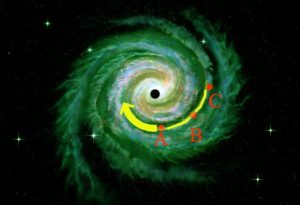« Black Hole » and « Big Bang »
A « Black Hole » is an astrophysical object which general relativity says is caused by a mass sufficiently concentrated that it keeps collapsing in on itself due to its own gravitation, even managing to concentrate at a point called the « gravitational singularity ».
At the center of each galaxy is a Black Hole (nascent, mature). The shape of the spiral arms of the galaxy indicates a centrifugal movement which determines its evolution in space and time. Like a siphon, the “Black Hole” is the engine of this cyclonic movement of the stars. And the antiquity of these galaxies implies different arm shapes due to the “Black Hole” existing in its center. The shape of the spiral arms informs of the age of the “Black Hole”.
The Black Hole « sucks » in a rotational movement all the materials under its influence and concentrates in this dark zone. Aspiration is a term very poorly suited to the Black Hole phenomenon, but easier to use for my explanations.
The Black Hole concentrates the matter / wave, in a restricted volume, which results at a given moment (explained later) in such a concentration of energy in such a small volume, that this volume such as a balloon will explode in a big Bang. Every Black Hole whether in formation or mature will end in a Big Bang.
(By analogy take a pan of water and heat it, after a while the gas concentrates in a gas bubble in the water which will then explode on the surface of the water)
We feel like the universe is expanding from a single origin because the stars are moving away from us.
Another theory is possible. The galaxies end up in the Black Hole by traversing the path indicated by the spiral arm. These paths are the arms of the galaxies. Our solar system sits on one arm of the galaxy spiraling towards the Black Hole. The closer the material approaches the Black Hole, the faster its movement speed increases.
The luminary (image point A) which are on an arm of the  galaxy, between our solar system (image point B) and the end of the course, that is to say the Black Hole is moving away from us more and more quickly because their speed increases compared to ours. So we have the impression that they are moving away from us. Indeed,
galaxy, between our solar system (image point B) and the end of the course, that is to say the Black Hole is moving away from us more and more quickly because their speed increases compared to ours. So we have the impression that they are moving away from us. Indeed,
The planet (point C image) which are behind us (point B image) on this path of the arm, in the direction of movement, are going slower than us, so we are moving away from these luminary, and our point of view gives the illusion let them move away from us, yet it is we who move away from these planet. This combination of phenomenon gives the impression that the stars are moving away according to the usual theory.
Why are black holes a place where matter/waves concentrate?
Let’s look at the electron and the nucleus of an atom. The electron has a negative electrical charge and the nucleus of the atom is positive, why doesn’t it stick together?
Like a galaxy, the nucleus of an atom turns very quickly on itself and the electron (wave) is in an infernal rotation around the nucleus (by analogy: like a blender grinds fruit, the rotation throws the mixed matter on the wall, the electron is electrically attracted by the nucleus but repelled by the rotation of the nucleus, an equilibrium is created and the electron is stable on its bearing). It is the same principle for the moon which does not crash into the earth despite Newton’s gravitation.
Let’s imagine in my theory that the core stops rotating, then an imbalance is created (analogy: it is the principle of the spinning top which falls if the rotation disappears, like an airplane wing the air which supports the spinning top, loss of speed causes loss of lift).
The negatively charged electrons stick to the positively charged nucleus and the temperature drops (less movement). The imbalance then propagates from atom to atom, from matter to matter like a set of dominoes that cause each other to fall And the concentration begins (the electrons stick to the nucleus of the atoms) and you have just created a new Black Hole.
The distance between the electrons and the nucleus becomes zero, the inter-matter distances become zero, which generates this hyper concentration which is not an aspiration but an extreme concentration.
When there is no longer enough matter to concentrate (to « suck up »), so that the galaxy has completely disappeared (because it is concentrated) then absolute cold (0 K) is reached for all this matter.
The machine restarts and restarts the rotation (because for a few moments the temperature could even be negative <0°k (impossible?)) of the nuclei which then repel the electrons in a huge expansion called a big bang.
A new and almost instantaneous big bang.
Thank you for your comments:
windtrap@windtrap.fr
m l sene